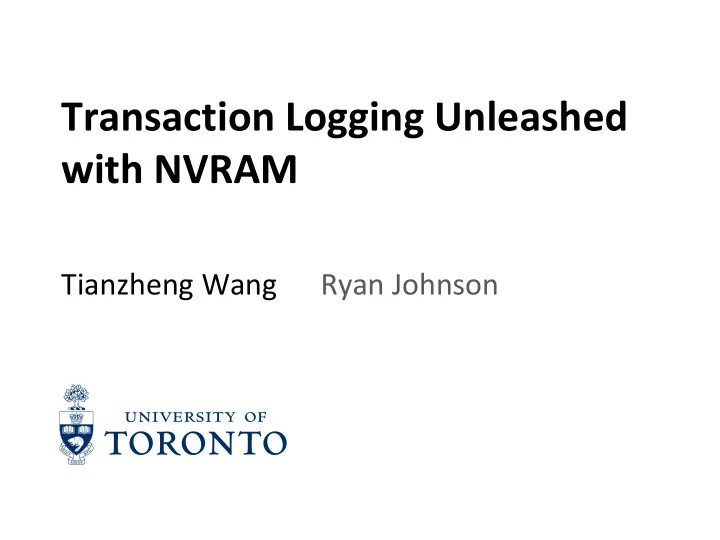

Transaction Logging Unleashed with NVRAM Tianzheng Wang Ryan Johnson
No, I’m not talking about the syslog 1
Write-ahead logging Used by most transactional systems Databases , file systems… Reliability Everything goes to the log first, then the real place Replay winners, rollback losers Data Data Update Update Bal=500 Bal=500 1. Log it 2. Really change it 1. Log it 2. Really change it Performance Buffer log records in DRAM Disk/storage friendly long, sequential writes 2
Write-ahead logging Used by most transactional systems Databases , file systems… Reliability Everything goes to the log first, then the real place All was good until we had Replay winners, rollback losers massively parallel hardware Data Data Update Update Bal=500 Bal=500 1. Log it 2. Really change it 1. Log it 2. Really change it Performance Buffer log records in DRAM Disk/storage friendly long, sequential writes 3
Centralized log: a serious bottleneck Ideal Reality Transaction DRAM threads Log buffer on commit CPU Log 46% - Log Storage Other Flush cycles work contention Why not distribute the log? 4
Sure! But need the help of byte-addressable, non-volatile memory (NVRAM). 5
The (impractical) distributed log Log space partitioning T1 T2 T3 T4 by page or xct? Impacts locality and recovery c d e f g h a b Dependency tracking Direct xct deps: T4 T2 Log 1 Log 2 Log 3 Log 4 a d c e f g Direct page deps: T4 T3 Transitive deps: T4 { T3 , T2 } T1 T1 T2 T3 T4 Easily end up flushing all logs Storage is slow a e g d f c Log 1 Log 2 Log 3 Log 4 System becomes I/O bound 6
The (impractical) distributed log * R. Johnson etc., “ Aether : a scalable approach to logging”, PVLDB 2010 7
The (impractical) distributed log Heavy dep. tracking + slow I/O = showstoppers * R. Johnson etc., “ Aether : a scalable approach to logging”, PVLDB 2010 8
NVRAM to the rescue NVRAM as log buffers for distributed logging Log records durable once written No dep tracking or flush-before-commit Heavy dep. tracking + slow I/O = ( SOLVED ) 9
System architecture Before: After: Log buffer (DRAM) Log buffers (NVRAM) Contend on a single Less or no contention log buffer Flush when buffers are Flush on commit or full or timeout timeout 10
Challenges NUMA effects Durability – processor cache is volatile Database system implications Ordering Uniqueness of log records Recovery Checkpointing … 11
Problem #1: NUMA effects Partition-by-page => easier/simpler recovery Threads prefer to access local NVM node Transaction level: Page level: NUMA NUMA NUMA NUMA P1 node 1 node 2 node 1 node 2 P2 P2 NUMA-friendly Cross NUMA boundary Prefer to partition by xct 12
Problem #2: LSN gives partial order Log sequence numbers only good in any one log Recovery needs total order in any log/xct/page Recovery The same page manager: being modified: Same LSNs, Transaction whom first? threads: smaller ≠ earlier! Log buffers: 1 2 … 1 2 … By-xct d-log needs global ordering of log records 13
Solution #2: global sequence number Based on Lamport’s clock, no extra contention How? Bump GSNs when the Page: transaction latches pages and inserts log records Pg GSN: 1 – 2 – 3 3 – 8 – 9 0 7 GSN: Page Transaction Log Tx GSN: 2 8 EX-latch max(pg’s, tx’s) + 1 / 3 9 SH-latch / max(pg’s, tx’s ) / 2 3 … 8 9 … Log bufs: Log ins. max (pg’s, tx’s, log’s) + 1 GSN gives a partial, global order in each page, tx and log 14
Problem #3: Volatile CPU caches Log records must leave CPU cache before commit, preferably without dependency-tracking The ultimate solution: durable processor cache Candidates: FeRAM, SRAM + Supercapacitor … Kiln [MICRO-46] Whole system persistence [ASPLOS ’12] Rohm nonvolatile CPU But not available on the market 15
Problem #3: Volatile CPU caches Log records must leave CPU cache before commit, preferably without dependency-tracking Stop-gap solution: passive group commit Passive group commit daemon Get min dGSN: 8 TXN dGSN dGSN dGSN dGSN Xct 1 5 on commit: 1. Flush local caches Xct 2 10 Dequeue xct with 2. Update local dGSN dGSN <= 8 Commit queue 3. Enqueue transaction 16
Evaluation Setup 4-socket, 6-core Xeon E7- 4807 @ 1.8GHz 24 physical cores, 48 “CPUs” with hyper threading 64GB DRAM NVM: flash/super-capacitor backed DRAM Workloads Shore-MT, with Aether* TPC-C: online transaction processing TATP: telecom database applications * R. Johnson etc., “Aether: a scalable approach to logging”, PVLDB 2010 17
TATP – write intensive Distributed vs. centralized logging 18
TATP – write intensive Passive group commit 19
TPC-C – full transaction mix Distributed vs. centralized logging 20
TPC-C – full transaction mix Passive group commit 21
Conclusion Centralized logging is a serious bottleneck NVRAM resurrects d-log to scale databases Practical distributed log today Passive group commit Flash/super-capacitor backed DRAM (NVDIMM) Find out more in our VLDB paper: Scalable Logging through Emerging Non-Volatile Memory http://www.vldb.org/pvldb/vol7/p865-wang.pdf Thank you! 22
Recommend
More recommend